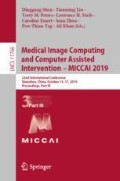Abstract
Functional connectomes can successfully predict behavioral measures. While the majority of the literature uses a single connectome to predict a single behavioral measure, there is ample evidence that combining different connectomes and behavioral measures reveals more robust neural correlates. Here, we proposed a prediction framework that combines connectomes from multiple sources (e.g. task and resting-state fMRI) and predicts a latent phenotype, derived from a battery of behavioral measures. The framework relies on a novel generalization of canonical correlation analysis with both a closed-form and an iterative solution. We applied the framework to data from the Human Connectome Project (HCP) to predict a latent, general intelligence factor. Prediction accuracy was higher for this latent factor than any single measure of intelligence, showing the advantage of combining multiple connectomes and behavioral measures in a single predictive model.
Access this chapter
Tax calculation will be finalised at checkout
Purchases are for personal use only
References
Dubois, J., Adolphs, R.: Building a science of individual differences from fMRI. Trends Cogn. Sci. 20(6), 425–443 (2016)
Greene, A.S., Gao, S., Scheinost, D., Todd Constable, R.: Task-induced brain state manipulation improves prediction of individual traits. Nat. Commun. 9(1), 2807 (2018)
Gao, S., Greene, A.S., Todd Constable, R., Scheinost, D.: Combining multiple connectomes via canonical correlation analysis improves predictive models. In: Frangi, A.F., Schnabel, J.A., Davatzikos, C., Alberola-López, C., Fichtinger, G. (eds.) MICCAI 2018. LNCS, vol. 11072, pp. 349–356. Springer, Cham (2018). https://doi.org/10.1007/978-3-030-00931-1_40
Dubois, J., Galdi, P., Paul, L.K., Adolphs, R.: A distributed brain network predicts general intelligence from resting-state human neuroimaging data. Philos. Trans. R. Soc. B: Biol. Sci. 373(1756), 20170284 (2018)
Van Essen, D.C., et al.: The WU-Minn human connectome project: an overview. Neuroimage 80, 62–79 (2013)
Shen, X., et al.: Using connectome-based predictive modeling to predict individual behavior from brain connectivity. Nat. Protocols 12(3), 506–518 (2017)
Asendorf, N.A., Informative data fusion: Beyond canonical correlation analysis (2015)
Stewart, G.W.: A krylov-schur algorithm for large eigenproblems. SIAM J. Matrix Anal. Appl. 23(3), 601–614 (2002)
Alexander, D.L.J., Tropsha, A., Winkler, D.A.: Beware of R\(^{2}\): simple, unambiguous assessment of the prediction accuracy of QSAR and QSPR models. J. Chem. Inf. Model. 55(7), 1316–1322 (2015)
Acknowledgements
Data were provided in part by the Human Connectome Project, WU-Minn Consortium (Principal Investigators: David Van Essen and Kamil Ugurbil; U54 MH091657) funded by the 16 NIH Institutes and Centers that support the NIH Blueprint for Neuroscience Research; and by the McDonnell Center for Systems Neuroscience at Washington University.
Author information
Authors and Affiliations
Corresponding author
Editor information
Editors and Affiliations
Rights and permissions
Copyright information
© 2019 Springer Nature Switzerland AG
About this paper
Cite this paper
Gao, S., Shen, X., Todd Constable, R., Scheinost, D. (2019). Combining Multiple Behavioral Measures and Multiple Connectomes via Multipath Canonical Correlation Analysis. In: Shen, D., et al. Medical Image Computing and Computer Assisted Intervention – MICCAI 2019. MICCAI 2019. Lecture Notes in Computer Science(), vol 11766. Springer, Cham. https://doi.org/10.1007/978-3-030-32248-9_86
Download citation
DOI: https://doi.org/10.1007/978-3-030-32248-9_86
Published:
Publisher Name: Springer, Cham
Print ISBN: 978-3-030-32247-2
Online ISBN: 978-3-030-32248-9
eBook Packages: Computer ScienceComputer Science (R0)


